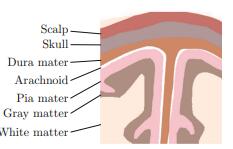The long-term reliability of the neural electrode is closely related to its implantation behavior. In orderto realize the quantitative research of the implantation behavior in a low-cost and accurate way, a refined brainmodel containing meninges is proposed. First, the expected simulation material was selected through measuringthe elastic modulus based on the method of atomic force microscope indentation technique. As a result, the 2%(mass fraction) agarose gel simulated the gray and white matter, the 7 : 1 (volume ratio) polydimethylsiloxane(PDMS) sheet simulated the pia mater, and the polyvinyl chloride (PVC) film simulated the dura mater. Second,based on designing a three-layer structure mold, the brain model was prepared by inverted pouring to realizea flat implantation surface. Finally, the simulation behavior of the brain model was investigated with the ratbrain as a reference. For mechanical behavior of implantation, the implantation force experienced two peaks bothin the brain model and the rat brain, maximum values of which were 10.17 mN and 7.69 mN respectively. Thelarger implantation force in the brain model will increase the strength requirement for the electrode, but reducethe risk of buckling of that in practical application. For humoral dissolution behavior, the dissolution rates ofthe polyethylene glycol (PEG) coating of the electrode in the brain model and rat brain were 7 000 μm3/s and5 600 μm3/s, respectively. The faster dissolution rate in the brain model will cause the larger thickness of thecoating design but provide sufficient implantable time in practical application. The establishment of the brainmodel and the research of its simulated behavior are beneficial to the size design of the electrode substrate andcoating, and research of the implantation mechanism, and further increase the functional life of the electrode.

贺雨欣,张文光,胥浩天,徐倚帆,许李悦
. Establishment of a Refined Brain Model for Evaluating Implantation Behavior of Neural Electrode and Research of its Simulated Behavior[J]. Journal of Shanghai Jiaotong University(Science), 2023
, 28(4)
: 401
.
DOI: 10.1007/s12204-022-2523-5
[1] BOEHLER C, CARLI S, FADIGA L, et al. Tutorial:Guidelines for standardized performance tests for electrodes intended for neural interfaces and bioelectronics[J]. Nature Protocols, 2020, 15(11): 3557-3578.
[2] HONG G S, LIEBER C M. Novel electrode technologies for neural recordings [J]. Nature Reviews Neuroscience, 2019, 20(6): 330-345.
[3] KOZAI T D Y, JAQUINS-GERSTL A S, VAZQUEZ AL, et al. Brain tissue responses to neural implants impact signal sensitivity and intervention strategies [J].ACS Chemical Neuroscience, 2015, 6(1): 48-67.
[4] ZHANG W G, MA Y K, LI Z W. Experimental evaluation of neural probe’s insertion induced injury based ondigital image correlation method [J]. Medical Physics,2016, 43(1): 505-512.
[5] YIN X L, ZHANG W G, TANG J Q, et al. Micromotion simulation and optimal design of multi-shank fishbone-shaped electrode [J]. Journal of Shanghai JiaoTong University, 2019, 53(5): 529-534(in Chinese).
[6] NA K, SPERRY Z J, LU J A, et al. Novel diamondshuttle to deliver flexible neural probe with reducedtissue compression [J]. Microsystems & Nanoengineering, 2020, 6: 37.
[7] WEN X M, WANG B, HUANG S, et al. Flexible, multifunctional neural probe with liquid metal enabled,ultra-large tunable stiffness for deep-brain chemicalsensing and agent delivery [J]. Biosensors and Bioelectronics, 2019, 131: 37-45.
[8] LECOMTE A, DESCAMPS E, BERGAUD C. A review on mechanical considerations for chronicallyimplanted neural probes [J]. Journal of Neural Engineering, 2018, 15(3): 031001.
[9] AIMEDIEU P, GREBE R. Tensile strength of cranialpia mater: Preliminary results [J]. Journal of Neurosurgery, 2004, 100(1): 111-114.
[10] JOO H R, FAN J L, CHEN S P, et al. A microfabricated, 3D-sharpened silicon shuttle for insertionof flexible electrode arrays through dura mater intobrain [J]. Journal of Neural Engineering, 2019, 16(6):066021.
[11] ZHANG W G, ZHOU X H, HE Y X, et al. Implantingmechanics of PEG/DEX coated flexible neural probe:Impacts of fabricating methods [J]. Biomedical Microdevices, 2021, 23(1): 17.
[12] ZHOU X H, ZHANG W G, XIE J. Effects of micromilling and laser engraving on processing qualityand implantation mechanics of PEG-dexamethasonecoated neural probe [J]. Journal of Shanghai Jiao TongUniversity (Science), 2021, 26(1): 1-9.
[13] WALSH D R, ZHOU Z, LI X G, et al. Mechanical properties of the cranial meninges: A systematic review [J].Journal of Neurotrauma, 2021, 38(13): 1748-1761.
[14] ZHAO Z T, LI X, HE F, et al. Parallel, minimallyinvasive implantation of ultra-flexible neural electrodearrays [J]. Journal of Neural Engineering, 2019, 16(3):035001.
[15] CHEN P C, CLARK C, SHEN C P J, et al. Ultrasonically actuated inserted neural probes for increased recording reliability [C]//2013 Transducers &Eurosensors XXVII: The 17th International Conference on Solid-State Sensors, Actuators and Microsystems. Barcelona: IEEE, 2013: 872-875.
[16] MESA-MúNERA E, RAMíREZ-SALAZAR J F,BOULANGER P, et al. Inverse-FEM characterizationof a brain tissue phantom to simulate compression andindentation [J]. Ingenier′?ay Ciencia, 2012, 8(16): 11-36.
[17] RUNZA M, PIETRABISSA R, MANTERO S, et al.Lumbar dura mater biomechanics: Experimental characterization and scanning electron microscopy observations [J]. Anesthesia and Analgesia, 1999, 88(6): 1317-1321.
[18] CASTAGNOLA V. Implantable microelectrodes onsoft substrate with nanostructured active surface forstimulation and recording of brain activities [D].Toulouse: Universite Toulouse III Paul Sabatier, 2014.
[19] CHEN X, ZENG Z, ZHANG H, et al. Study on methods of obtain elastic modulus of rabbit keratocytes byforce volume model of AFM [J]. Beijing BiomedicalEngineering, 2020, 39(6): 574-581 (in Chinese).
[20] NOMOEV A V, LYGDENOV V T, KHARTAEVAE C, et al. Measurement of the Young’s modulusof composite polymer coatings using atomic forcemicroscopy [J]. AIP Conference Proceedings, 2020,2288(1): 030092.
[21] MCCRACKEN P J, MANDUCA A, FELMLEE J,et al. Mechanical transient-based magnetic resonanceelastography [J]. Magnetic Resonance in Medicine,2005, 53(3): 628-639.
[22] HE Y X, ZHANG W G, XU L Y, et al. Implantationstrategies of invasive flexible neural electrode [J]. Journal of Medical Biomechanics, 2021, 36(1): 151-157 (inChinese).
[23] WANG X C, HIRSCHBERG A W, XU H J, et al.A parylene neural probe array for multi-region deepbrain recordings [J]. Journal of MicroelectromechanicalSystems, 2020, 29(4): 499-513.
[24] SHI B, HAO X, LUO D, et al. Effect of erythrocyteon brain water content and expression of HO-1 in ratwith traumatic intracerebral hemorrhage [J]. ChineseJournal of Nervous and Mental Diseases, 2007, 33(11):666-668 (in Chinese).



